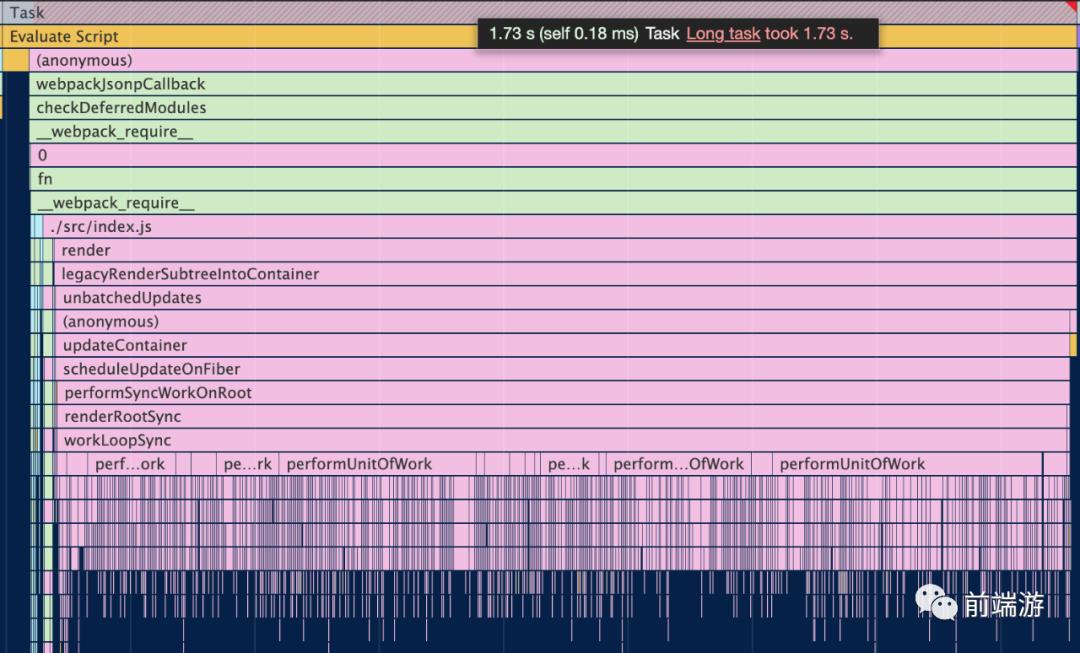React 源码解读之 Concurrent
Posted 前端游
tags:
篇首语:本文由小常识网(cha138.com)小编为大家整理,主要介绍了React 源码解读之 Concurrent相关的知识,希望对你有一定的参考价值。
引言
为了提升用户体验,React 团队提出了 Concurrent 模式。Concurrent 模式可以在应用更新的同时保持浏览器对用户的响应,并根据用户的设备性能和网速进行适当的调整。我们通过一个例子来看看 Legacy 模式和 Concurrent 模式之间的区别:
例子中的页面有个正方形,我们给它加了一个动画效果,会左右来回移动。id 为 root 的 div 为 React 应用的挂载点。
<style>
@keyframes move {
from {
margin-left: 0;
}
to {
margin-left: 200px;
}
}
#square {
width: 100px;
height: 100px;
margin-top: 10px;
background-color: red;
animation: move 2s ease 0s infinite alternate;
}
</style>
<body>
<div id="square"></div>
<div id="root"></div>
</body>
我们的 React 应用比较简单,渲染了 2000 个颜色不一的正方形,为了模拟繁重的渲染工作,我们让每一个 Item 函数组件执行的时候运行一个比较耗时的 for 循环:
const Item = ({i}) => {
for (let i = 0; i< 999999;i++){}
return <span key={i} style={{
display: 'inline-block',
width: '5px',
height: '5px',
backgroundColor: `rgb(${255*Math.random()},${255*Math.random()},${255*Math.random()})`
}} />
}
const App = () => {
const n = 2000
return (
<div style={{fontSize:0}}>
{[...new Array(n)].map((_, i) => {
return <Item i={i} />
})}
</div>
)
}
以下是 Legacy (ReactDOM.render(<App />, rootEle)) 和 Concurrent (ReactDOM.unstable_createRoot(rootEle).render(<App />)) 两种模式渲染效果的对比:
Legacy
Concurrent

可以看到,Legacy 模式下,正方形出现后就不动了,一直要等到渲染过程完全结束后动画才开始进行,而 Concurrent 模式下则没有出现这种情况。
通过浏览器的 performance 面板,我们发现 Legacy 模式下 Render 阶段(详见)都在一个 Task 中完成,导致该 Task 执行时间过长,阻塞了浏览器的其他工作:

而 Concurrent 模式下, Render 阶段被分成了一个个的小任务:
实现时间切片这个功能,少不了 React 新加入的 Scheduler(调度器),这个就是本文所要研究的内容。
Scheduler
Scheduler(调度器)是 React16 新增的内容,它负责调度任务的优先级。从该库的说明中可看到,该库未来是想要成为一个通用的库:
This is a package for cooperative scheduling in a browserenvironment. It is currently used internally by React,but we plan to make it more generic.
所以我们这里也先抛开 React,来看看它有些什么功能。
调度任务优先级
import Scheduler from 'react/packages/scheduler'
Scheduler.unstable_scheduleCallback(2, function func1() {
console.log('1')
})
const task = Scheduler.unstable_scheduleCallback(1, function func2(didTimeout){
console.log('2')
})
Scheduler.unstable_scheduleCallback 第一个参数为任务的优先级(越小越高)。所以上面的例子先打印 2,再打印 1。
这里有几个点需要注意:
1 Scheduler.unstable_scheduleCallback 会返回一个 task,该 task 有如下属性:
| 属性 | 说明 |
|---|---|
| id | 略 |
| callback | 传入 unstable_scheduleCallback 的函数 |
| priorityLevel | 传入 unstable_scheduleCallback 的优先级 |
| startTime | 任务的开始时间 |
| expirationTime | 任务的过期时间 |
| sortIndex | 任务用于排序的字段,一般为 startTime 或 expirationTime 的值 |
2 任务回调函数在执行时会传入一个参数,即上述代码中的 didTimeout,该参数表示当前任务是否已经过期。
延迟任务执行
import Scheduler from 'react/packages/scheduler'
Scheduler.unstable_scheduleCallback(2, function func1() {
console.log('1')
})
Scheduler.unstable_scheduleCallback(1, function func2(){
console.log('2')
}, {delay: 100})
Scheduler.unstable_scheduleCallback 第三个参数的 delay 字段可以让当前任务延时执行,即使当前任务优先级较高。所以上面的例子先打印 1,再打印 2。注意到
取消任务
import Scheduler from 'react/packages/scheduler'
Scheduler.unstable_scheduleCallback(2, function func1 () {
console.log('1')
})
const task = Scheduler.unstable_scheduleCallback(1, function func2(){
console.log('2')
})
Scheduler.unstable_cancelCallback(task)
通过 Scheduler.unstable_cancelCallback 可以取消某个任务。所以上面的例子只会打印 1。
持续调度
import Scheduler from 'react/packages/scheduler'
function func2(didTimeout) {
if (!didTimeout) console.log(2)
}
function func1() {
console.log(1)
return func2
}
Scheduler.unstable_scheduleCallback(1, func1)
当 Scheduler.unstable_scheduleCallback 所调度的任务的 callback 返回值仍然为函数时,会继续在当前 Task 中执行这个返回的函数。所以上面的例子会先打印 1,当再次执行 func2 的时候由于 didTimeout 为 true,所以不会打印 2。
让出时间
import Scheduler from 'react/packages/scheduler'
function work() {
while(!Scheduler.unstable_shouldYield()) {
console.log('work')
}
console.log('yield to host')
}
Scheduler.unstable_scheduleCallback(1, function func2(){
work()
})
通过 Scheduler.unstable_shouldYield 可以判断当前是否还有时间供任务运行。上面的例子会持续打印 work 一段时间后,最后打印 yield to host。
时间切片
了解上述基本用法之后,我们来模拟一下 React 中使用时间切片来进行 Render 的过程:
import Scheduler from 'react/packages/scheduler'
function createLinkedList(n) {
let p = {
value: `Node 1`,
next: null
}
const head = p
for (let index = 1; index < n; index++) {
p.next = {
value: `Node ${index+1}`,
next: null
}
p = p.next
}
return head
}
const head = createLinkedList(9000)
let workInProgress = head
function workLoopConcurrent() {
while (workInProgress !== null && !Scheduler.unstable_shouldYield()) {
performUnitOfWork(workInProgress);
}
}
function workLoopSync() {
while (workInProgress !== null) {
performUnitOfWork(workInProgress);
}
}
function performUnitOfWork(unitOfWork) {
for (let i = 0; i< 999999;i++){}
console.log(performance.now(), unitOfWork.value)
workInProgress = unitOfWork.next
}
function run(didTimeout) {
// 当前这个 task 已经过期了,啥都不管了,同步把剩下的工作完成
if (didTimeout) workLoopSync()
// 当前这个 task 还没过期,可以悠着点,干一会歇一会
else workLoopConcurrent()
if (workInProgress !== null) {
return run
}
return null
}
const NormalPriority = 3;
animate()
Scheduler.unstable_scheduleCallback(NormalPriority, run)
该例子首先创建了一个包含 2000 节点的链表,并将表头赋值给 workInProgress,然后调度了一个任务来执行 run,该函数中根据当前任务是否过期分别调用 workLoopSync 或 workLoopConcurrent。两者的区别是,workLoopSync 会一次性同步把整个链表处理完,而 workLoopConcurrent 会在每个时间切片中处理一部分任务,当需要让出时间时,会停止 while 循环。
回到 run 函数,如果 workInProgress 不为空,即链表还未遍历完时,会返回 run 函数继续在当前调度的这个 task 中运行。这样循环了若干次后,当某次再执行 run 时 didTimeout 会为 true,此时会使用同步方式把剩下的任务一次性全部完成。
接下来我们看看这个时间切片到底是怎么实现的吧。
时间切片实现原理
首先,我们先来看看 unstable_scheduleCallback:
function unstable_scheduleCallback(priorityLevel, callback, options) {
var currentTime = getCurrentTime();
// 根据 options 确定 startTime
var startTime;
if (typeof options === 'object' && options !== null) {
...
} else {
...
}
// 根据优先级确定 timeout,优先级越大 timeout 越小,即越早过期
var timeout;
switch (priorityLevel) {
...
}
var expirationTime = startTime + timeout;
// 一个新的任务
var newTask = {
id: taskIdCounter++,
callback,
priorityLevel,
startTime,
expirationTime,
sortIndex: -1,
};
if (enableProfiling) {
newTask.isQueued = false;
}
if (startTime > currentTime) {
// 任务被延迟,即 options 中指定了 delay
newTask.sortIndex = startTime;
push(timerQueue, newTask);
if (peek(taskQueue) === null && newTask === peek(timerQueue)) {
// All tasks are delayed, and this is the task with the earliest delay.
if (isHostTimeoutScheduled) {
// Cancel an existing timeout.
cancelHostTimeout();
} else {
isHostTimeoutScheduled = true;
}
// Schedule a timeout.
requestHostTimeout(handleTimeout, startTime - currentTime);
}
} else {
newTask.sortIndex = expirationTime;
push(taskQueue, newTask);
if (enableProfiling) {
markTaskStart(newTask, currentTime);
newTask.isQueued = true;
}
// 调度一个 host callback.如果当前已经调度了一个则等到下一次让出时间的时候再说
if (!isHostCallbackScheduled && !isPerformingWork) {
isHostCallbackScheduled = true;
requestHostCallback(flushWork);
}
}
return newTask;
}
该方法首先会确定 currentTime、startTime、expirationTime,然后会新建一个 newTask,并将要调度的方法作为该对象的 callback 属性。
接着,根据该任务是否已经开始来确定走不同的分支,如果该任务还未开始,则将其放入 timerQueue 中,如果开始了则放入 taskQueue。其中 timerQueue 和 taskQueue 都是通过最小堆实现的优先级队列,timerQueue 中的元素通过 startTime 来排序,taskQueue 中的元素通过 expirationTime 排序。
我们的时间切片例子中没有指定 delay,所以我们这里会走到 else 中,将 newTask 放入到 taskQueue 中后,会执行 requestHostCallback(flushWork)。这一步会开启一个宏任务,在该任务中执行 flushWork。
查看代码可知 React 是通过 MessageChannel 来实现的:
const channel = new MessageChannel();
const port = channel.port2;
channel.port1.onmessage = performWorkUntilDeadline;
function requestHostCallback(callback) {
scheduledHostCallback = callback;
if (!isMessageLoopRunning) {
isMessageLoopRunning = true;
port.postMessage(null);
}
}
这里先用 scheduledHostCallback 缓存了传递过来的 flushWork,当执行 port.postMessage(null) 时会触发执行 performWorkUntilDeadline:
const performWorkUntilDeadline = () => {
if (scheduledHostCallback !== null) {
const currentTime = getCurrentTime();
// shouldYieldToHost 中通过这个来判断是否应该让出时间
// yieldInterval 为 5ms,即一个时间切片内任务执行超过 5ms 就需要让出
deadline = currentTime + yieldInterval;
const hasTimeRemaining = true;
let hasMoreWork = true;
try {
hasMoreWork = scheduledHostCallback(hasTimeRemaining, currentTime);
} finally {
if (hasMoreWork) {
port.postMessage(null);
} else {
isMessageLoopRunning = false;
scheduledHostCallback = null;
}
}
} else {
isMessageLoopRunning = false;
}
needsPaint = false;
};
该函数中首先会更新 deadline,这个变量比较重要,shouldYieldToHost 中就是通过这个来判断是否应该让出时间,其中 yieldInterval 为 5ms,即一个时间切片内任务执行超过 5ms 就需要让出。该函数中最后调用了 scheduledHostCallback 即 flushWork:
function flushWork(hasTimeRemaining, initialTime) {
...
isPerformingWork = true;
const previousPriorityLevel = currentPriorityLevel;
try {
if (enableProfiling) {
try {
return workLoop(hasTimeRemaining, initialTime);
} catch (error) {
...
}
} else {
// No catch in prod code path.
return workLoop(hasTimeRemaining, initialTime);
}
} finally {
currentTask = null;
currentPriorityLevel = previousPriorityLevel;
isPerformingWork = false;
...
}
}
这里,主要是执行了 workLoop,该函数的工作主要是不断从 taskQueue 中拿出任务 currentTask 进行处理:
function workLoop(hasTimeRemaining, initialTime) {
let currentTime = initialTime;
// 把 timerQueue 中开始的任务挪到 taskQueue 中
advanceTimers(currentTime);
currentTask = peek(taskQueue);
while (
currentTask !== null &&
!(enableSchedulerDebugging && isSchedulerPaused)
) {
if (
currentTask.expirationTime > currentTime &&
(!hasTimeRemaining || shouldYieldToHost())
) {
// 当前任务没有过期且时间切片用完了,需要让出
break;
}
// 这里的 callback 是我们调用 unstable_scheduleCallback 传入的 callback
const callback = currentTask.callback;
if (typeof callback === 'function') {
// 重置当前 task 的 callback 为 null
currentTask.callback = null;
currentPriorityLevel = currentTask.priorityLevel;
const didUserCallbackTimeout = currentTask.expirationTime <= currentTime;
markTaskRun(currentTask, currentTime);
const continuationCallback = callback(didUserCallbackTimeout);
currentTime = getCurrentTime();
if (typeof continuationCallback === 'function') {
// 调用 unstable_scheduleCallback 传入的 callback 返回值仍然为函数时,继续使用当前任务来调度这个函数,这样一个任务中就会做很多件事情
currentTask.callback = continuationCallback;
markTaskYield(currentTask, currentTime);
} else {
// 调用 unstable_scheduleCallback 传入的 callback 返回值不会函数
if (enableProfiling) {
markTaskCompleted(currentTask, currentTime);
currentTask.isQueued = false;
}
// 这里要判断一下的原因是有可能 callback 中又插入了优先级更高的任务
if (currentTask === peek(taskQueue)) {
pop(taskQueue);
}
}
advanceTimers(currentTime);
} else {
pop(taskQueue);
}
currentTask = peek(taskQueue);
}
if (currentTask !== null) {
// 告诉 performWorkUntilDeadline 还有任务,则 performWorkUntilDeadline 会再开启一个任务:
/**
try {
hasMoreWork = scheduledHostCallback(hasTimeRemaining, currentTime);
} finally {
if (hasMoreWork) {
port.postMessage(null);
} else {
isMessageLoopRunning = false;
scheduledHostCallback = null;
}
}
**/
return true;
} else {
// taskQueue 中没有任务了,timerQueue 有任务
const firstTimer = peek(timerQueue);
if (firstTimer !== null) {
// requestHostTimeout 就是 setTimeout
// 此时我们拿出 timerQueue 第一个任务 firstTimer,即最早开始的那个任务
// 我们延迟 firstTimer.startTime - currentTime 这个时间后,执行 handleTimeout
requestHostTimeout(handleTimeout, firstTimer.startTime - currentTime);
}
return false;
}
}
当结束循环时,有两种情况:
currentTask不为空,此时返回true告诉performWorkUntilDeadline还有工作,则performWorkUntilDeadline会开启一个新的宏任务来继续处理。这样,就又开启了新一轮的performWorkUntilDeadline->flushWork->workLoop。currentTask为空,此时如果timerQueue也不为空的话,按理说跟currentTask不为空时一样的处理方式也可,因为timerQueue中的任务总会在某一次调度的过程中开始,但是这样可能会导致有很多宏任务中什么任务都没有执行,白白造成浪费。于是这里采用了一个更高效的做法,即直接通过setTimeout来开启一个宏任务,而setTimeout的延迟时间是timerQueue第一个任务(即最早开始的那个任务)与当前时间的差值。而setTimeout开启的宏任务中,执行的是handleTimeout:
function handleTimeout(currentTime) {
isHostTimeoutScheduled = false;
// 将 timerQueue 中已开始的任务移到 taskQueue 中
advanceTimers(currentTime);
if (!isHostCallbackScheduled) {
if (peek(taskQueue) !== null) {
isHostCallbackScheduled = true;
requestHostCallback(flushWork);
} else {
const firstTimer = peek(timerQueue);
if (firstTimer !== null) {
requestHostTimeout(handleTimeout, firstTimer.startTime - currentTime);
}
}
}
}
这里调用了 requestHostCallback(flushWork),剩下的流程就跟之前的一样了。也许你会好奇这里为什么存在 peek(taskQueue) 为空这种情况,因为有可能从 requestHostTimeout 到 handleTimeout 这一段时间内,用户取消掉了最早开始的那个任务。
至此,时间切片的大致运行流程就分析完了,可用下图表示:
总结
本文首先通过一个列子引出了 React 的 Concurrent 模式,然后介绍了 Scheduler 的基本使用方法并模拟了 React 在 Concurrent 模式下是如何使用时间切片来进行 Render 的,最后分析了时间切片的实现原理。
参考
1. Introducing Concurrent Mode (Experimental): https://reactjs.org/docs/concurrent-mode-intro.html
以上是关于React 源码解读之 Concurrent的主要内容,如果未能解决你的问题,请参考以下文章
Java源码之 java.util.concurrent 学习笔记01
第1945期彻底搞懂React源码调度原理(Concurrent模式)
ElasticSearchEs 源码之 Discovery DiscoveryModule Coordinator 源码解读
ElasticSearchEs 源码之 Discovery DiscoveryModule ZenDiscovery 源码解读